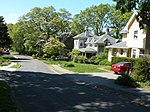Arthur H. Russell House
Houses in Winchester, MassachusettsHouses on the National Register of Historic Places in Winchester, MassachusettsWinchester, Massachusetts Registered Historic Place stubs

The Arthur H. Russell House is a historic house in Winchester, Massachusetts. The 2+1⁄2-story wood-frame house was built in 1899 for Arthur H. Russell, a Boston lawyer who also served as moderator of Winchester's town meetings. The house is a distinctive local example of Medieval Revival styling, with heavily shingled elements, decorative vergeboard trim, and window styles of varying size and window pane type.The house was listed on the National Register of Historic Places in 1989.
Excerpt from the Wikipedia article Arthur H. Russell House (License: CC BY-SA 3.0, Authors, Images).Arthur H. Russell House
Rangeley Road,
Geographical coordinates (GPS) Address Nearby Places Show on map
Geographical coordinates (GPS)
| Latitude | Longitude |
|---|---|
| N 42.448055555556 ° | E -71.141388888889 ° |
Address
Rangeley Road 38
01890
Massachusetts, United States
Open on Google Maps











